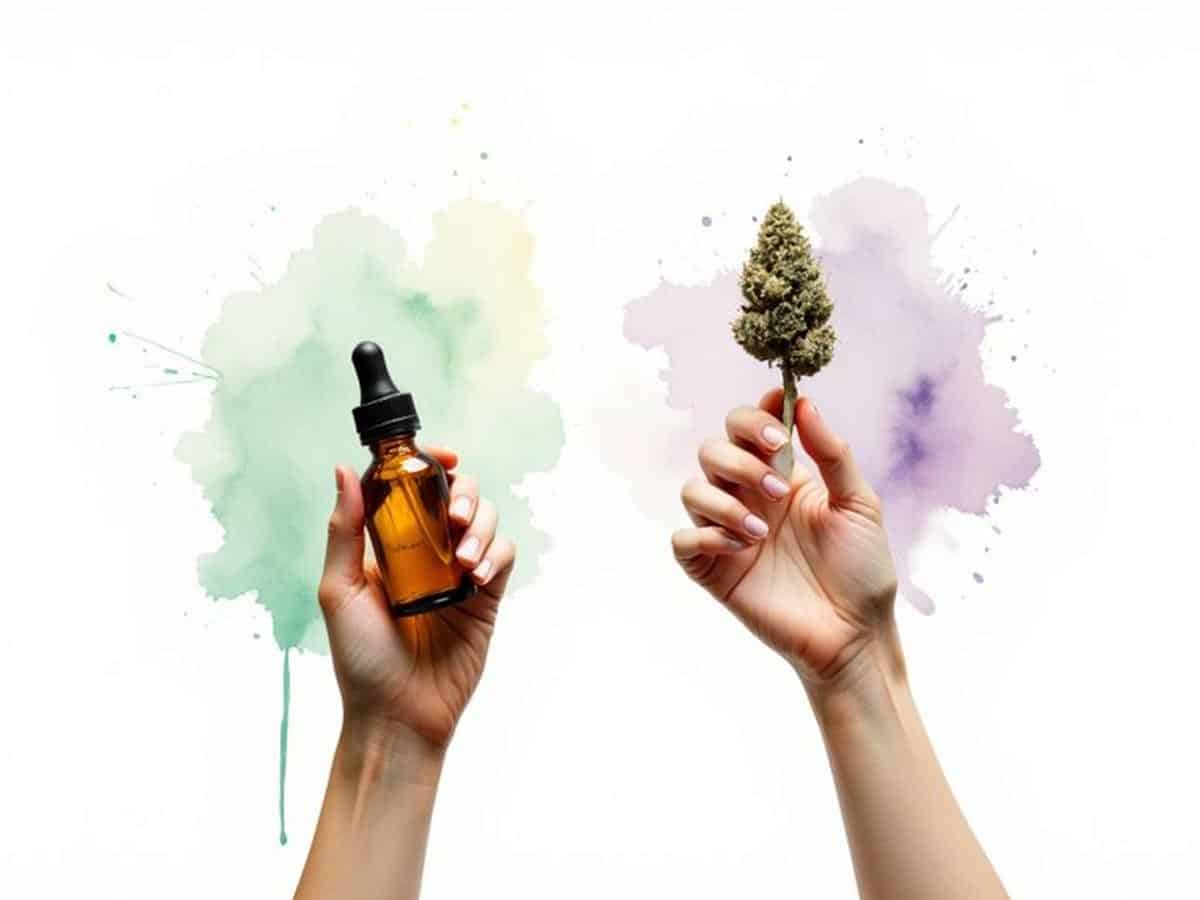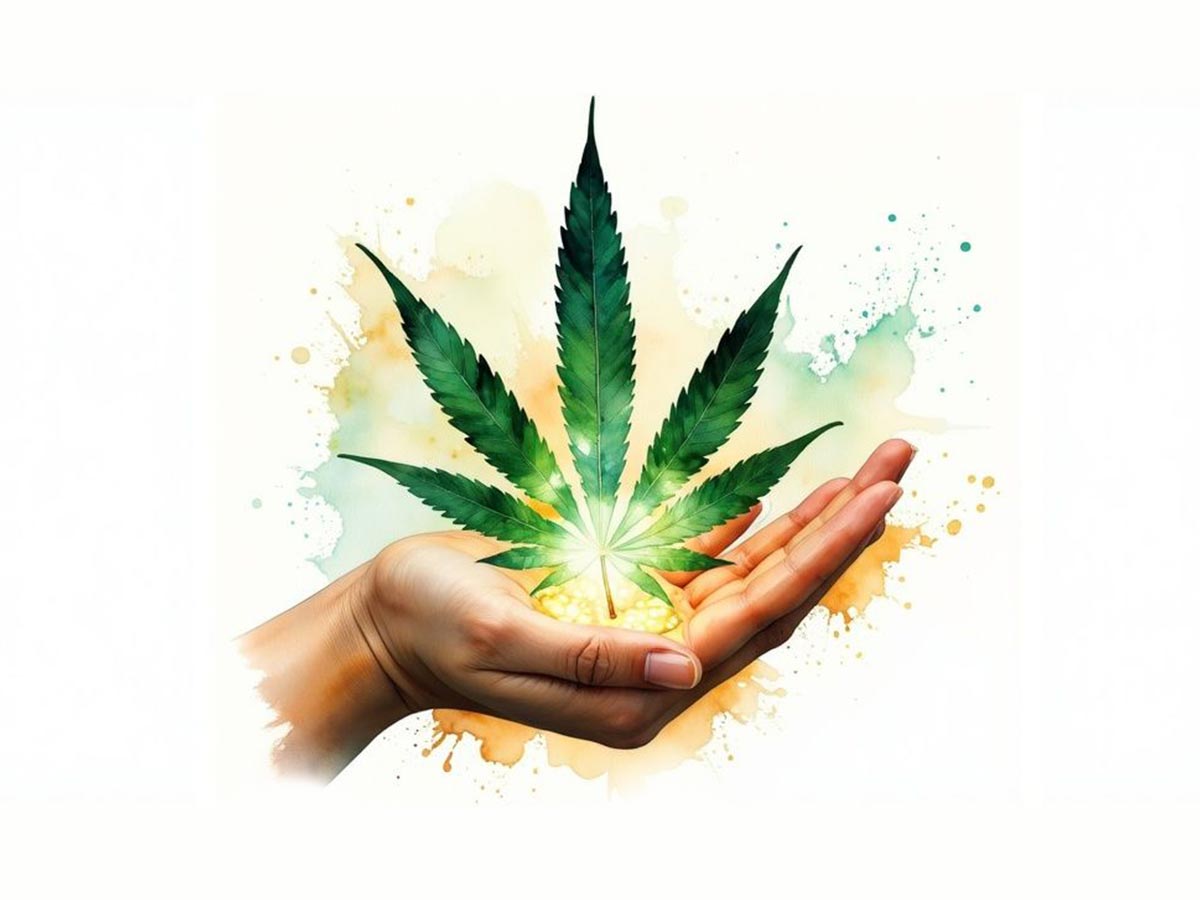Let’s cut right to the chase and clear up the biggest question surrounding CBD and THC. The main difference is straightforward: THC gets you ‘high,’ while CBD does not.
Though they both come from the same Cannabis sativa plant, the way they affect your body and mind couldn’t be more different. This single distinction changes everything—from their legal status to how you’ll feel after using them, and ultimately, which one is right for you.
What Really Separates CBD and THC?
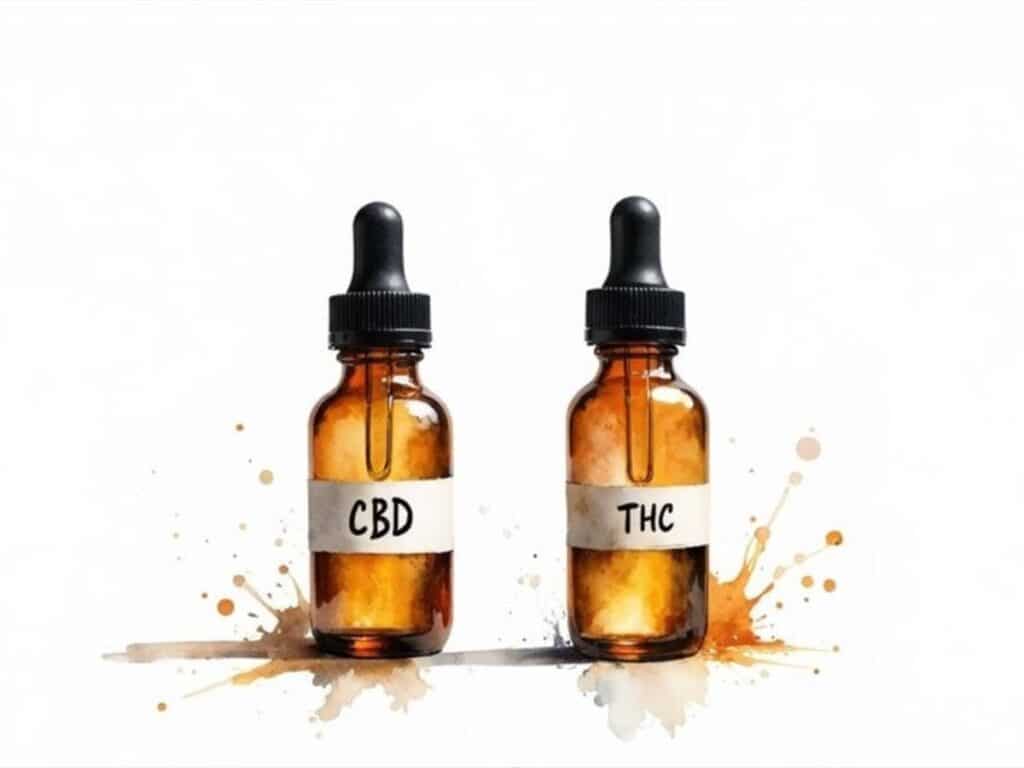
When people talk about cannabis, they often treat it as one single thing. In reality, the plant is a complex chemical factory producing hundreds of unique compounds called cannabinoids. CBD (Cannabidiol) and THC (Tetrahydrocannabinol) are just the two most famous.
THC is known for its psychoactive effects—it’s the compound responsible for the euphoric, sometimes intoxicating, feeling associated with marijuana. CBD, on the other hand, is completely non-psychoactive. People turn to it for its potential therapeutic benefits, like calming anxiety or reducing inflammation, without any change in their mental state.
A Tale of Two Molecules
Here’s a practical way to think about it: if the cannabis plant is an apple tree, CBD and THC are two different kinds of apples. One is crisp and energizing, the other is sweet and relaxing. They grow on the same tree but deliver a completely different experience.
This fundamental split is why CBD has become a wellness superstar, appearing in everything from tinctures to topical creams, while THC remains a carefully regulated substance. The interest in CBD is huge and still growing; recent studies show that around 60% of American adults have given a CBD product a try. You can dive deeper into the numbers with this detailed report on CBD statistics and trends.
For a quick reference, here’s a breakdown of the most important distinctions.
CBD vs THC Core Differences at a Glance
This table gives you a simple, at-a-glance look at what sets these two compounds apart. It’s perfect for making a quick, informed decision without getting lost in the weeds.
| Attribute | CBD (Cannabidiol) | THC (Tetrahydrocannabinol) |
|---|---|---|
| Psychoactive Effect | No. Does not produce a “high.” | Yes. Creates the classic cannabis “high.” |
| Primary Use Cases | Wellness, anxiety relief, pain, inflammation. | Recreation, pain relief, appetite, sleep aid. |
| Federal Legal Status | Legal if from hemp (under 0.3% THC). | Federally Illegal. Legal in many states. |
| How It Works | Influences the body’s systems indirectly. | Binds directly to brain receptors (CB1). |
Ultimately, this comparison highlights that the right choice is all about your personal goals and what you want to achieve.
The key takeaway? Your choice between CBD and THC comes down to your desired outcome. Are you looking for therapeutic benefits without the high, or are you seeking a compound with noticeable psychoactive properties?
At a chemical level, CBD and THC have almost the exact same molecular formula. But a tiny, almost insignificant difference in how their atoms are arranged is what causes their radically different effects. That one small structural tweak is the entire reason one alters your state of mind and the other doesn’t.
How CBD and THC Interact with Your Body
To truly understand the CBD vs. THC debate, we have to look at how they work on a biological level. It all comes down to a fascinating network in our bodies called the endocannabinoid system (ECS). Think of the ECS as your body’s internal balancing act, working tirelessly to keep things like your mood, appetite, sleep, and immune response in a state of equilibrium, or homeostasis.
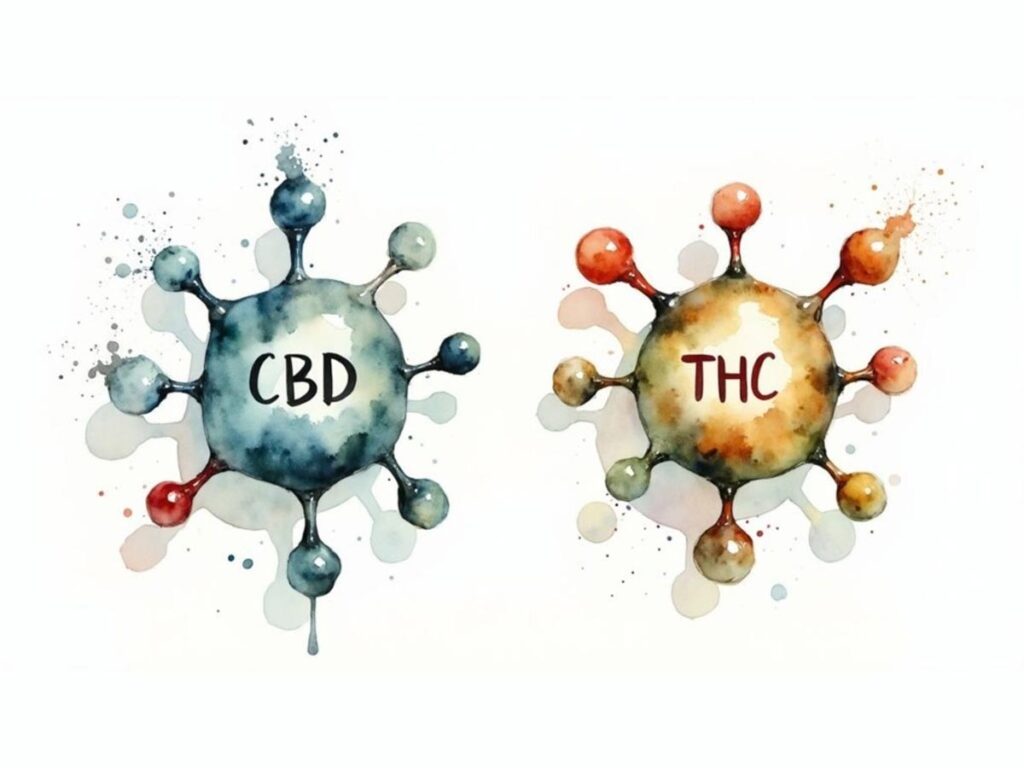
This system has receptors all over your brain and body, but the two main players are the CB1 and CB2 receptors. The wildly different effects of CBD and THC stem directly from how each one interacts with these specific receptors.
THC: The Direct Activator
THC’s approach is direct and potent. Its molecular structure is a near-perfect match for CB1 receptors, which are found in high concentrations throughout the brain and central nervous system. It’s like a key sliding perfectly into a lock.
When THC binds to these CB1 receptors, it directly impacts functions like pleasure, memory, focus, and perception. This direct activation is what creates the euphoric “high” that cannabis is famous for. It’s an immediate and unmistakable effect.
In a nutshell, tetrahydrocannabinol (THC) is the principal psychoactive compound in cannabis responsible for the ‘high’ effect. By binding so effectively to CB1 receptors, THC alters mood, cognition, and sensory perception. Despite these psychoactive properties, THC is a cornerstone of many medical cannabis treatments. To get a better grasp of its role, you can discover more about the applications of medical cannabis and its evolving market dynamics.
CBD: The Indirect Influencer
CBD, on the other hand, plays a much different game. It’s more of a system-wide influencer than a direct activator. Instead of binding tightly to CB1 or CB2 receptors, CBD works in more subtle, behind-the-scenes ways. Think of it less like a key and more like a helpful stage manager for your body’s internal systems.
Here’s a practical example of how it operates:
- It helps boost your body’s own naturally produced endocannabinoids. Specifically, it can inhibit the breakdown of anandamide, often called the “bliss molecule,” letting it stick around longer to improve your mood.
- It interacts with other non-cannabinoid receptors in the body, like serotonin receptors, which can influence mood and anxiety.
- It can subtly change the shape of CB1 receptors, which can make it harder for THC to bind to them.
The Modulating Effect: This last point is really interesting in practice. If you’ve ever heard of someone using CBD to lessen the intensity of a THC high, this is why. CBD can actually tone down some of THC’s less desirable side effects, like anxiety or paranoia, leading to a more mellow and balanced experience.
This indirect, modulating action is precisely why CBD doesn’t get you high. It doesn’t take over the system; it just helps it run a little more smoothly.
A Practical Analogy: The Lead Singer vs. The Conductor
Let’s put this into a simple analogy. Imagine your endocannabinoid system is a full orchestra, with each section representing a different function—pain, mood, sleep, etc.
- THC is the charismatic lead singer. They grab the microphone, and their voice immediately becomes the center of attention, defining the sound and feel of the entire performance. The effect is powerful, direct, and impossible to ignore.
- CBD is the orchestra conductor. The conductor doesn’t play an instrument or sing a note. Instead, they guide the entire orchestra, ensuring every section works in harmony, adjusting the tempo and volume to create a perfectly balanced and cohesive piece of music.
This core difference is what you need to consider when weighing what is cbd vs thc for your own wellness goals. Are you looking for a direct, noticeable effect, or do you need gentle, background support to help your body find its own balance? Understanding how they work inside you is the first step to making an informed choice.
Comparing Real-World Therapeutic Benefits
Beyond the chemistry, the real question is simple: how can these compounds actually help you? The answer depends entirely on what you’re trying to achieve. Both CBD and THC have impressive therapeutic potential, but they are not interchangeable. Picking the right one is all about matching the compound to your specific wellness goals.
The fundamental difference comes down to their practical application. CBD has built a solid reputation for daily wellness support because it does its job without causing impairment. That makes it a practical, everyday choice for managing chronic issues that you deal with day in and day out.
On the other hand, THC is the heavy hitter, often reserved for more severe symptoms. Its powerful effects, including the psychoactivity, are frequently what’s needed to bring relief from intense conditions where a gentler approach just won’t cut it.
When to Consider CBD for Wellness
CBD is brilliant at providing subtle, non-intoxicating support. It’s the first stop for people looking to manage ongoing issues without brain fog or interference with daily responsibilities. Because it works more indirectly with the body’s systems, it’s a versatile tool for helping maintain a sense of balance.
Here are a few practical examples where CBD is often the go-to:
- Managing Daily Anxiety: For that constant hum of general unease or social stress, a CBD tincture can help promote calm without making you drowsy. It just takes the edge off, letting you move through your day more comfortably. To dive deeper, you can explore the best cannabis strains for anxiety and find what might work for you.
- Reducing Chronic Inflammation: If you’re dealing with arthritis or nagging joint pain, a topical CBD cream can offer targeted relief. It’s widely used for its anti-inflammatory properties when applied directly to the source of pain.
- Addressing Certain Seizure Disorders: One of the most medically-backed uses for CBD is in managing specific, rare forms of epilepsy. Its neuroprotective qualities are so well-recognized that it’s the active ingredient in FDA-approved medications.
When THC Offers More Potent Relief
When symptoms are intense and seriously impact your quality of life, THC’s direct handshake with the brain’s CB1 receptors delivers a level of relief that CBD often can’t match. Yes, it comes with psychoactive effects, but sometimes that’s a necessary trade-off for its powerful benefits.
THC is typically brought in for more acute and severe situations:
- Alleviating Severe or Chronic Pain: For deep-seated pain from conditions like neuropathy or cancer, THC’s ability to change how the brain perceives pain can be a game-changer.
- Stimulating Appetite: Patients undergoing chemotherapy often face a debilitating loss of appetite. THC is famous for bringing on “the munchies,” a side effect that can be a critical therapeutic benefit.
- Combating Nausea and Vomiting: Similarly, THC is incredibly effective at taming the nausea that can accompany aggressive medical treatments.
This visual gives a quick rundown of the core differences in how CBD and THC work in the body, focusing on psychoactivity and potential side effects.
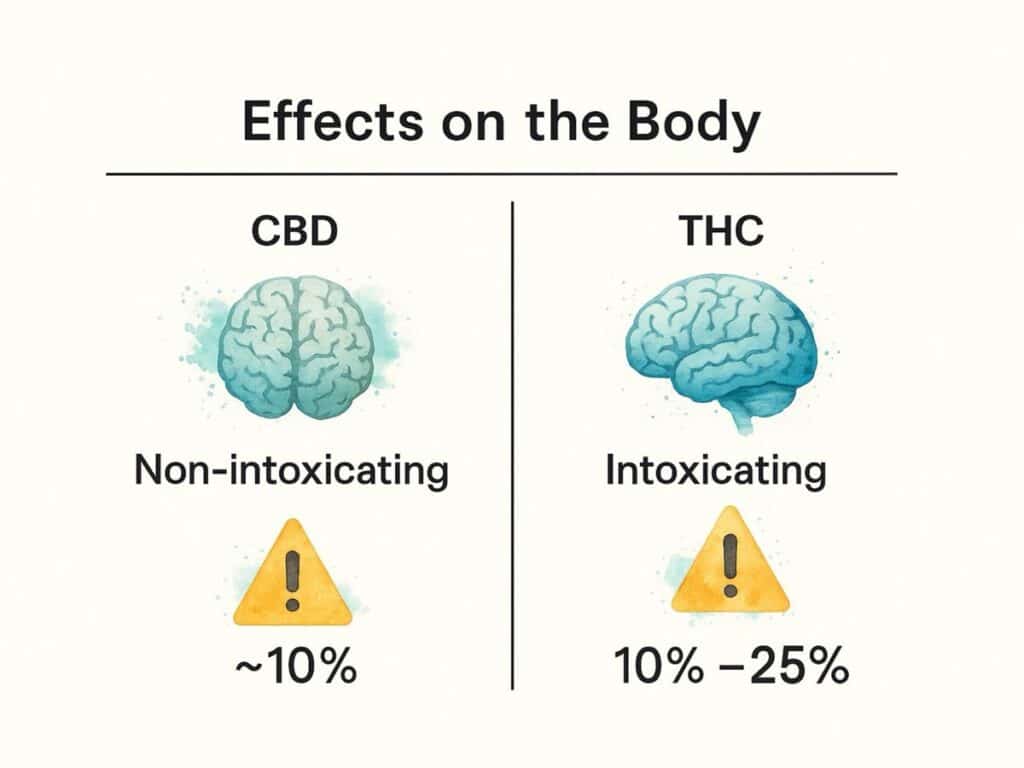
As you can see, THC’s intoxicating effects come with a higher chance of side effects—a key thing to consider when figuring out which compound fits your life and your needs.
To help you see how this plays out in the real world, here’s a look at some common use cases and which cannabinoid typically takes the lead.
Situational Uses for CBD vs THC
| Condition/Use Case | Primary Use for CBD | Primary Use for THC | Notes on Combined Use |
|---|---|---|---|
| Anxiety & Stress | Excellent for generalized anxiety and daily stress due to its calming, non-intoxicating effects. | Can be effective for some, but may cause paranoia in others, especially at higher doses. | A CBD-dominant ratio (e.g., 20:1) can provide anxiety relief while minimizing THC’s potential side effects. |
| Chronic Pain | Best for inflammation-based pain like arthritis. Provides localized relief without a “high.” | Better for neuropathic (nerve) and severe centralized pain due to its direct action on brain receptors. | Combining them often yields the best results; THC targets the pain signaling while CBD reduces inflammation. |
| Sleep Issues | Helps with sleep by addressing root causes like anxiety or pain. It’s not a direct sedative. | Highly effective as a sedative, helping people fall asleep faster. Can sometimes affect sleep quality long-term. | A balanced 1:1 ratio is a popular choice for sleep, offering sedation from THC and relaxation from CBD. |
| Appetite Stimulation | Generally does not stimulate appetite. | Very effective for increasing appetite, particularly for patients with wasting syndrome or undergoing chemotherapy. | Adding CBD can help manage other symptoms like nausea without interfering with THC’s appetite-boosting effects. |
| Nausea & Vomiting | Mildly effective for some, but not its strongest application. | Considered a first-line cannabinoid treatment for chemotherapy-induced nausea due to its potent antiemetic properties. | Combining the two can provide broader symptom relief, as CBD may help with associated inflammation or anxiety. |
This table shows there’s a lot of nuance. The best choice often depends on the severity of the condition and your personal tolerance.
Unlocking the Entourage Effect
The conversation isn’t always “CBD or THC?” In fact, many experienced users will tell you the magic is in using them together. This is thanks to a phenomenon known as the entourage effect—a theory that cannabinoids work better as a team than they do flying solo.
A great practical example is pain relief. A product with both CBD and THC might offer the potent painkilling effects of THC, while the CBD steps in to mellow out any anxiety or paranoia that THC might otherwise cause. This synergy creates a more balanced, effective, and tolerable experience.
This collaborative approach is precisely why “full-spectrum” and “broad-spectrum” products are so popular. They contain a whole symphony of cannabinoids, including trace amounts of THC, that work in concert. Finding the right ratio of CBD to THC can be a personalized journey to wellness that plays to the strengths of both compounds.
Navigating the Complex Legal Differences
Trying to understand cannabis law can feel like untangling a knotted fishing line. The rules for CBD and THC are worlds apart, and this isn’t just legal jargon—it directly affects what you can buy, where you can buy it, and whether you could get into trouble for using it. The entire distinction hinges on one plant and one very specific number.
Everything changed with the 2018 Farm Bill. This piece of federal legislation officially legalized hemp, defining it as any Cannabis sativa plant that contains 0.3% THC or less by dry weight. That single rule carved out a legal space for hemp-derived CBD products, effectively separating them from marijuana in the eyes of the law.
This is the very reason you now see CBD oils, gummies, and creams sold everywhere from health food stores to online shops. As long as the product comes from hemp and doesn’t cross that 0.3% THC line, it’s considered federally legal.
The Federal and State Divide
While hemp-derived CBD has a clear path to legality, THC’s situation is much murkier. Any cannabis plant with more than 0.3% THC is still classified as marijuana, which remains a Schedule I controlled substance at the federal level. That puts it in the same league as heroin and LSD.
But that’s not the whole story, is it? We all know that a growing number of states have given THC the green light for either medical or recreational use, creating a massive conflict between state and federal laws. This patchwork of regulations means a THC product you can buy legally in one state could land you in serious legal hot water just one state over.
Key Takeaway: When it comes to legality, the plant source is everything. If it’s from hemp (≤0.3% THC), you’re generally in the clear nationwide. If it’s from marijuana (>0.3% THC), its legality depends entirely on the laws of the specific state you’re in.
This legal split has real, practical consequences. It’s why you can only buy THC products at licensed dispensaries in certain states, while CBD is sold almost everywhere. It’s also why the rules around purchasing cannabis products online can be so confusing. For anyone wondering about the details, you can learn more about whether it is legal to buy edibles online to stay on the right side of the law.
Practical Implications for You
This legal maze isn’t just about what you can buy—it can impact your job, your ability to travel, and your personal safety.
- Employment and Drug Testing: Here’s an actionable insight: even if you stick to federally legal, hemp-derived CBD, you’re not completely in the clear. Full-spectrum CBD products contain trace amounts of THC. While it’s a tiny amount, it can build up in your system over time and potentially cause you to fail a drug test. People have lost their jobs over this, all while believing they were using a “THC-free” product.
- Travel Considerations: Flying or driving with cannabis products is a gamble. Crossing state lines with THC—even if you’re traveling between two states where it’s legal—is a federal offense. While the TSA says it isn’t actively searching for your personal stash, they must report it to law enforcement if they find it. CBD is much safer to travel with, but it’s always wise to carry a copy of the lab reports to prove its THC content is within the legal limit.
- Product Reliability: The CBD market is like the Wild West—largely unregulated. This means the responsibility falls on you, the consumer, to be vigilant. Never buy a product without first checking for a Certificate of Analysis (COA) from a third-party lab. This document is your proof of what’s actually in the bottle, verifying the cannabinoid levels and confirming it’s below the legal THC threshold. Without a COA, you’re just guessing.
Choosing the Right Product and Method
Knowing the difference between CBD and THC is one thing, but putting that knowledge to work at the dispensary counter is another. You’re faced with a wall of options: oils, gummies, vapes, creams—it’s a lot to take in. The best choice isn’t just about picking a cannabinoid; it’s about finding the right product and consumption method that fits your specific goals and lifestyle.
Think of it like this: the way you consume a cannabinoid completely changes the experience. It dictates how fast you’ll feel it, how long it will last, and the nature of the effects. There’s no single “best” way, only the best way for you and your needs.
Matching the Method to Your Needs
Different situations call for different tools. If you’re dealing with a sudden flare-up of symptoms, you’ll want something that acts fast. For all-day relief, a slower, more sustained method is the way to go. Let’s look at how the most common methods stack up in the real world.
- Tinctures and Oils: These are the versatile middle ground. Taken under the tongue (sublingually), they get absorbed pretty quickly, usually within 15 to 45 minutes. The effects stick around for a few hours, making them perfect for handling a sudden wave of anxiety or getting ahead of chronic pain before it gets overwhelming.
- Edibles and Capsules: Patience is key here. When you eat or swallow a cannabinoid, it has to pass through your digestive system first, so you won’t feel anything for 60 to 120 minutes. The payoff for that wait is long-lasting relief. The effects can last a solid 6 to 8 hours, which is ideal for managing persistent, all-day issues.
- Topicals and Creams: Got a sore knee or an aching muscle? Topicals are your best friend. You apply these lotions and balms directly to the skin, where they go to work on localized pain and inflammation. Since they don’t enter the bloodstream, you get targeted relief without any psychoactive effects—even if the product has THC.
- Inhalation (Vaping/Smoking): This is the speed demon of consumption methods. When you inhale, the cannabinoids go straight to your lungs and into your system, delivering effects in just a few minutes. That speed comes with a trade-off, though: the effects are the shortest-lived, typically fading within 1 to 3 hours.
Situational Examples: Choosing CBD vs. THC
Let’s put this into practice. Say you have arthritis pain in your hands. A topical CBD cream would be a fantastic choice. It delivers anti-inflammatory compounds right where you need them, without making you feel fuzzy or affecting the rest of your body.
Now, imagine someone who struggles with sudden panic attacks. They need relief, and they need it now. A CBD tincture under the tongue is perfect for this, offering a fast enough onset to manage acute anxiety when it strikes. An edible would simply take too long to be effective.
Contrast that with someone using medical cannabis for severe, chronic back pain. A THC edible taken in the morning could provide a slow, steady stream of relief that lasts their entire workday, avoiding the ups and downs you’d get from a shorter-acting method like vaping.
The core principle is simple: match the product’s onset time and duration to the nature of your symptoms. For sudden issues, prioritize speed. For persistent problems, prioritize longevity.
Full-Spectrum, Broad-Spectrum, or Isolate?
Just when you think you’ve got it figured out, you’ll see products labeled as full-spectrum, broad-spectrum, or isolate. These terms are really important because they tell you what else is in the product besides just CBD or THC.
A full-spectrum product, for instance, contains all the cannabinoids and terpenes from the original plant, including trace amounts of THC. This is thought to create an “entourage effect,” where the compounds work better together. To really get a handle on how these compounds cooperate, our guide explaining what full-spectrum cannabis is breaks it all down. This is a critical distinction to make, especially if you’re subject to drug testing.
Making an Informed Choice for Your Needs
Alright, now that we’ve broken down the science behind CBD and THC, it’s time to figure out which one makes sense for you. This isn’t about abstract theory; it’s about matching the right tool to your specific situation and wellness goals.
The good news is, you don’t need a degree in chemistry to make a smart decision. It really just comes down to asking yourself a few honest questions about what you’re trying to achieve. Your answers will point you in the right direction.
Pinpointing Your Path
Let’s get practical. The best choice between CBD and THC almost always depends on the problem you’re trying to solve.
Think about these common scenarios:
- Looking to take the edge off daily stress without feeling out of it? A quality CBD product is your best bet. It can help calm your nerves without fogging up your brain, so you can stay focused and productive.
- Dealing with serious, diagnosed chronic pain where cannabis is legal? A product with THC might provide the stronger relief you need. THC’s ability to directly influence brain receptors often makes it more effective for intense pain that CBD alone can’t touch.
- Have sore muscles after a workout or achy joints? A topical CBD cream is a fantastic option. It lets you target the relief right where you need it without anything entering your bloodstream.
Thinking in terms of outcomes really clarifies the whole “CBD vs. THC” debate. It’s no surprise that as more people understand this, the market is growing. The global CBD market was valued at around USD 9.14 billion in 2024 and is expected to jump to USD 22.05 billion by 2030. This boom is all thanks to growing awareness and wider legalization. If you’re curious, you can dig into the global cannabidiol market trends to see just how quickly things are changing.
Universal Best Practices for a Safe Start
No matter which path you take, a few ground rules will set you up for a safe and positive experience. Think of these as the non-negotiables for anyone dipping their toes into the world of cannabinoids.
Your Safety Checklist: Always start with a low dose and go slow. Talk to your doctor before trying any new supplement, and stick with brands that provide up-to-date, third-party lab results (often called a Certificate of Analysis).
That last point about lab reports is a big one. The market is flooded with products, and not all of them are what they claim to be. A lab report is your only real proof that the ingredients on the label match what’s inside the product. It’s how you protect yourself and ensure you’re not accidentally taking more THC than you legally should. Following these simple steps will help you take control of your wellness with confidence.
Got Questions? We’ve Got Answers
Diving into the world of CBD and THC naturally brings up a lot of questions. Let’s tackle some of the most common ones you might have.
Can I Use CBD And THC At The Same Time?
You absolutely can, and many people find they work better together. This concept is called the “entourage effect,” which is just a way of saying the whole plant is often greater than the sum of its parts. Think of it like a team: CBD can help smooth out the edges of THC, potentially reducing feelings of anxiety and creating a more well-rounded experience. You’ll often see products sold with specific ratios to help you dial in that perfect balance.
Is CBD Going To Make Me Fail A Drug Test?
This is a big one, and the answer isn’t a simple yes or no. If you’re using a pure CBD isolate product, you should be in the clear, as it contains no THC. The complication comes with full-spectrum CBD, which legally can have up to 0.3% THC. While that’s a tiny amount, consistent use could cause it to build up in your system and, yes, potentially trigger a positive drug test.
If you get drug tested for work or any other reason, play it safe. Stick to products clearly labeled as broad-spectrum (where the THC has been removed) or CBD isolate. It’s a critical distinction—people have lost their jobs over trace amounts of THC from products they thought were “THC-free.”
What Are The Usual Side Effects?
CBD and THC interact with your body differently, so their side effects are quite distinct.
- CBD Side Effects: Most people tolerate CBD very well. When side effects do occur, they’re typically mild—things like fatigue, a change in appetite, or an upset stomach.
- THC Side Effects: These are directly linked to its psychoactive properties. You might experience the classic dry mouth and red eyes, but some people also report slower reaction times, coordination issues, or feelings of paranoia, particularly with higher doses.
Knowing what to expect helps you choose the cannabinoid that aligns with your goals and comfort level.
Ready to explore high-quality, lab-tested cannabis products with guidance from experts? At Elevation Headquarters, we offer a wide range of options, from premium topicals to expertly crafted edibles, all designed to meet your specific needs. Visit us to find the perfect product for your wellness journey.

